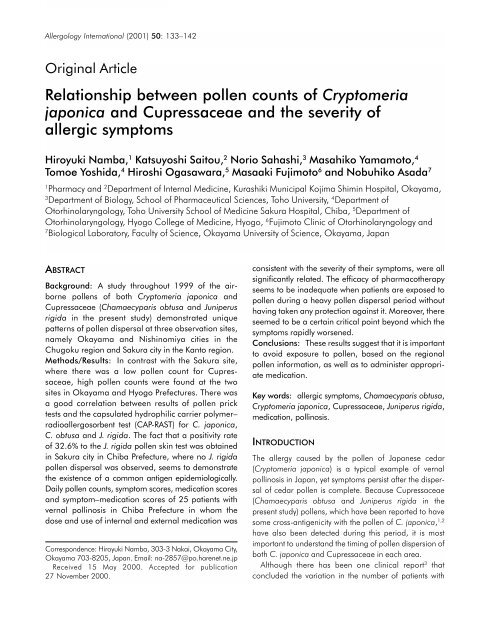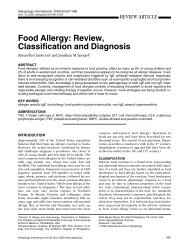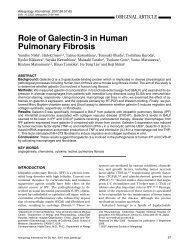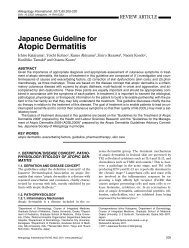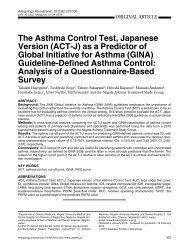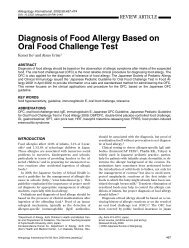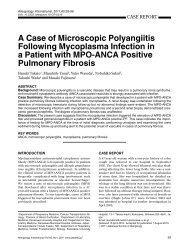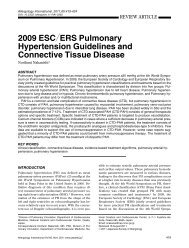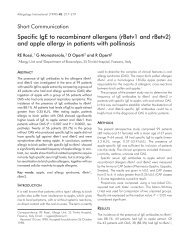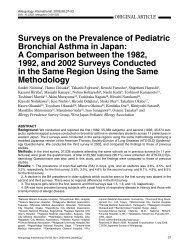Cryptomeria japonica - Allergology International
Cryptomeria japonica - Allergology International
Cryptomeria japonica - Allergology International
You also want an ePaper? Increase the reach of your titles
YUMPU automatically turns print PDFs into web optimized ePapers that Google loves.
134 H NAMBA ET AL.pollinosis was correlated with yearly C. <strong>japonica</strong> pollencounts and an epidemiological report 4 on the prevalenceof allergy to C. <strong>japonica</strong> pollen, there have been fewreports on the relationship between pollen counts, theseverity of allergic symptoms from exposure to pollen andpharmacotherapy for pollinosis patients. Moreover, therehave been no reports on dispersal conditions with regardto J. rigida pollen or of epidemiological surveys onJ. rigida pollinosis in Japan, except for those studiesperformed by Horiuti 5 and Miyoshi et al. 6 in OkayamaPrefecture.In the present study, we have investigated the dispersalof pollens at two sites in the Chugoku region (Okayamaand Hyogo Prefectures) and at one site in Chiba Prefecturein the Kanto region, which all have almost thesame latitude, in Japan. In addition, we performed skintests after obtaining the consent of patients who cameto the clinic during the C. <strong>japonica</strong> and Cupressaceaepollen-dispersal period and assessed the relationshipbetween C. <strong>japonica</strong>- and Chamaecyparis obtusa-specificIgE antibodies. We also investigated the relationshipbetween pollen counts, medication and degrees of subjectivesymptoms of pollinosis reported by the patients ina diary of pollinosis symptoms.The present study reveals some important relationshipsbetween the severity of pollinosis resulting fromexposure to pollen, the doses of medication taken bythe patients and the efficacy of these treatments againstthe symptoms.METHODSThe three observation sites for the determination of airbornepollen counts and the three hospitals where theskin test and in vitro test were performed are as describedbelow.We used Durham standard pollen samplers 7 forsampling pollen. Using Calberla liquid (glycerin 5 mL;ethanol 10 mL; Fuchsin Basic saturated liquid (WakoPure Chemicals, Osaka, Japan) 2 drops; purified water15 mL), 8 we stained pollen grains that had fallen naturallyonto glass slides and had been trapped within athin layer of white Vaseline (Maruishi Pharmaceutical,Osaka, Japan) over a period of 24 h from 08.30 h.The grains within a 3.24 cm –2 area (1.8 × 1.8 cm)were counted under a light microscope and the resultexpressed as pollen grains/cm –2 . The observation periodwas from the beginning of February until the end ofMay 1999.We recorded pollen dispersion from the day it beganuntil the day it ended, as well as the day of maximumpollen count and the total pollen counts for C. <strong>japonica</strong>and Cupressaceae. Our methods followed those of theAgreement Report of Working Group of Standardizationfor Pollen Information. 9Because the clinic in Okayama Prefecture, in whichoutpatients were examined, has not recorded data onpollens, pollen counts from Maple Pharmacy, the nearestto the clinic, were used. Patients were also examined attwo other clinics, one in Hyogo Prefecture and the otherin Chiba Prefecture. These observation sites, the localclinic and two hospitals are shown in Fig. 1. In OkayamaPrefecture, data were recorded at the Fujimoto Clinic ofOtorhinolaryngology, where outpatients were examinedusing the skin test and in vitro test, whereas the MaplePharmacy (Okayama City) was the observation site forpollen grains. In Hyogo Prefecture, outpatients wereexamined at Hyogo College of Medicine (NishinomiyaCity) using the skin test and in vitro test and pollen grainswere also observed here. In Chiba Prefecture, outpatientswere examined at the Toho University School of MedicineSakura Hospital (Sakura City) using the skin test andin vitro test and pollen grains were observed here also.Antigen extraction of C. <strong>japonica</strong> andCupressaceae, skin test and in vitro testAntigen extractions of pollen grains (C. <strong>japonica</strong>, C. obtusaand J. rigida) were made according to the methodreported by Sheldon et al. 10 After being dried and defatted,pollen grains were soaked in an extracting solution(defatted pollen grains 10.0 g; glycerin 25.0 mL; Toluene1 mL; buffered saline 50 mL; sterile distilled water415 mL) for 48 h.Buffered saline was made by adding 5 g sodiumchloride, 0.36 g monobasic potassium phosphate, 7.0 gdibasic sodium phosphate and 4.0 g phenol crystals todistilled water and making the solution up to a finalvolume of 1000.0 mL. The extracted solution was filteredthrough fluted paper and concentrated to 125 mL in theSeamless Cellophane Tubing 24/32 (Viskase, Chicago,IL, USA). Extracts were clarified by passing them througha millipore filter (pore size 0.22 µm) and 75 mL glycerinwas added to produce the skin testing solutions (1 : 20).The protein content of the pollen antigen preparationswas estimated with a spectrometer. 11 In order to checkthe quality of the pollen extracts, sodium dodecyl sulfate–polyacrylamide gel electrophoresis (SDS-PAGE) in 12.5%
AIRBORNE POLLENS AND ALLERGIC SYMPTOMS 135Fig. 1 Three observation sitesfor <strong>Cryptomeria</strong> <strong>japonica</strong> andCupressaceae and the threehospitals that examined patientswith pollinosis in Okayama,Hyogo and Chiba Prefectures.( ), the clinic that examinedthe patients; ( ), the site atwhich pollen grains only wereobserved; ( ), ( ), hospitalsthat observed pollen grains andalso examined patients.gel was performed according to the method of Laemmli 12and gels were stained with Coomassie Brilliant BlueG250 (Nacalai Tesque, Kyoto, Japan). After placing15 µL samples of the pollen extracts (1 : 20) in wells,electrophoresis was allowed to proceed for 150 min at20 mA. The marker proteins (Pharmacia Biotech, Amersham,UK) were phosphorylase b (94 kDa), bovine serumalbumin (67 kDa), ovalbumin (43 kDa), carbonic anhydrase(30 kDa), soybean trypsin inhibitor (20.1 kDa),and α-lactalbumin (14.4 kDa).Patients were tested by the prick-puncture skin test,according to the Report of the Working Group onConsultation Guidelines for Allergic Rhinitis. 13 The skinreaction was detected after 15 min. Wheals greater than5 mm in diameter or with a flare diameter greaterthan 10 mm were regarded as positive. If patients reactedto the control solution, we regarded them as positive onlyif the reaction to the pollen extract was more than twicethat of the control. To determine the serum levels ofspecific IgE antibody to the pollens, the Pharmacia-CAP system RAST (Pharmacia Diagnostics AB, Uppsala,Sweden) 14 was used in accordance with the manufacturer’srecommendations. Results are expressed in classes from0 to 6 and levels above class 1 were regarded as positive.Seventy-three patients (15 from Okayama; 15 fromHyogo; 43 from Chiba) were examined with the skin testand 56 patients (14 from Okayama; 14 from Hyogo; 28(C. <strong>japonica</strong>) and 20 (C. obtusa) from Chiba) were examinedwith CAP-RAST. Statistical analysis was performed byusing all results from the tests that could be performed inthe same patients.Diary recording pollinosis, symptom score(S score), medication score (M score) andsymptom–medication score (SM score)Patients diagnosed as having pollinosis to C. <strong>japonica</strong>and C. obtusa (positive to the prick-puncture skin testor the CAP-RAST examination) were required to keep adiary. Patients not only kept records in their pollinosisdiary of the doses of the medication they took each dayand the number of topical preparations they used, butthey also kept a record of their nasal and eye symptomsand of the degree of interference with their everydaylife that they experienced. They were asked to follow amanual 13,15 that had been prepared in advance withregard to recording these symptoms. We requestedpatients to record their use of appliances (pollinosisglasses and masks) to protect themselves against pollen.We asked them to either bring the diary to us or to post itin when the pollen dispersal period ended and they nolonger experienced any symptoms.
136 H NAMBA ET AL.Nasal symptoms of allergic rhinitis and the disturbanceto daily life were estimated to fall into one of five grades(ranging from – to ++++) and were scored on a scaleof 0–4 points according to the guidelines. 13 Eye symptomswere divided into two types, such as itchy eyes andwiping away of tears. Each symptom was estimated asbeing in one of the five grades and scored from 0–4according to the method reported by Okuda. 15 Either eyeitchiness or the number of times that tears were wipedwas used as the eye symptom score, depending on whichwas the most severe. 15 The S scores were calculatedaccording to the total of these three pollinosis symptoms.The medication prescribed to pollinosis patients followedrecommendations and was scored in accordancewith the guidelines 15 and the Japanese Society of <strong>Allergology</strong>.16 Table 1 shows the pharmacotherapy or M scorefor patients. The S score combined with the M score wasexpressed as the SM score. All these scores were averagedaccording to the number of patients.The investigation period was from 2 March to 10 April(completed 40 daily diary entries). We have studied therelationships among the daily pollen counts, daily S score,Table 1 Medication scores for treatments prescribed for pollinosisType of medicine Generic name Medication scoreOral medicationAnti-allergic agentsSuppression of IgE antibody production Suplatast tosilate 1 point/daySuppression of chemical mediator release Tranilastfrom mast cellsPemirolast potassiumNew-type antihistamines: Suppression of Ebastinechemical mediator release from mast Ketotifen fumaratecells, antihistamine effect etc.OxatomideEmedastine difumarateMequitazineAzelastine hydrochlorideEpinastine hydrochlorideAstemizoleTerfenadineCetirizine hydrochlorideOld-type antihistaminesD-Chlorpheniramine maleateOthersCombined agents D-Chlorpheniramine maleate + betamethasone 3 points/dayChinese herbal medicines Sho-seiryu-to extract 0.5 points/dayOther types of herbal medicineExternal medicationNasal dropsSuppression of chemical mediator release Sodium cromoglycate 1 point/dayfrom mast cellsNew-type antihistaminesKetotifen fumarateVasoconstrictorsTramazoline hydrochlorideNaphazoline nitrateSteroids Beclometasone dipropionate 2 points/dayFluticasone propionateFlunisolideEye dropsSuppression of chemical mediator release Sodium cromoglycate 1 point/dayfrom mast cellsTranilastNew-type antihistaminesKetotifen fumarateSteroids Fluorometholone 0.02% 2 points/dayDexamethasone sodiumMetasulfobenzoate 0.02%When pollinosis patients had not taken or used their daily dose of medicine, we divided them by the number of times per day and calculated dailymedication scores as the occasion demanded.
AIRBORNE POLLENS AND ALLERGIC SYMPTOMS 137daily M score and daily SM score of 25 patients (allpatients who recorded the circumstances regarding theiruse of medication and symptoms without interruption)in Chiba Prefecture.For statistical evaluation, regression analysis and theχ 2 -test were used. Differences were considered to significantat P < 0.05.RESULTSState of pollen dispersion for C. <strong>japonica</strong> andCupressaceae at the three observation sitesFigure 2 and Table 2 show the results for pollen dispersionof both C. <strong>japonica</strong> and Cupressaceae atthree observation sites in Okayama, Hyogo and ChibaPrefectures.<strong>Cryptomeria</strong> <strong>japonica</strong>Release of pollen from C. <strong>japonica</strong> was first observed on8 February at the Sakura site and lasted for 60 days.Release from the trees at the Okayama site began on16 February and lasted for 53 days. Pollen dispersionended at both sites at almost the same time, at the beginningof April. Pollen release began the latest at theNishinomiya site during the end of February. The expirationday was the earliest at the Nishinomiya site towardsthe end of March and the pollen dispersal period wasthe shortest at this site, lasting only 38 days. The day ofmaximum pollen count, during the early part of March,for C. <strong>japonica</strong> was at almost the same time at all threesites. The maximum pollen count was the highest for theNishinomiya site (count of 1912 pollen grains), whereaspollen counts at the other two sites were almost the sameat approximately 1200 pollen grains.CupressaceaePollen release from Cupressaceae was first observed atthe Okayama site on 12 March. The expiration day at theOkayama site was on 25 May and pollen dispersion continuedfor the longest period at this site, lasting 74 days.Release began at the Sakura site on 17 March and lastedfor 43 days before ending during the final days of April.Release at the Nishinomiya site was the most delayed anddid not begin until late March. The pollen dispersionlasted for 32 days at the Nishinomiya site and ended on24 April after the shortest period of dispersion. The timingof the maximum pollen counts at the three sites wasmarkedly different. At both the Okayama and Nishinomiyasites, maximum pollen counts were observed from thebeginning to the middle of April, whereas at the Sakurasite it occurred in late March. The pollen count at theOkayama site was 1163 pollen grains and this was thehighest of the three sites, with two peaks being observed.There was a peak pollen count of 566 pollen grains, withonly one peak, at the Nishinomiya site. There were only319 pollen grains counted at the Sakura site, with noclear peak.Skin test and RAST examinationThe protein content of the pollen preparations was2.47 mg/mL for C. <strong>japonica</strong>, 4.29 mg/mL for C. obtusaand 2.16 mg/mL for J. rigida. Sodium dodecyl sulfate–polyacrylamide gel electrophoresis was performed in12.5% gel and the C. <strong>japonica</strong> extract yielded threebands, one with a molecular weight of approximately94 kDa and two with molecular weights of approximately43 kDa each. The C. obtusa extract yielded five bands,three with molecular weights of approximately 75, 38and 25 kDa and two with molecular weights of approximately48 kDa each. The J. rigida pollen extract yieldedfour bands, two with molecular weights of approximately75 and 62 kDa and two with molecular weights ofapproximately 40 kDa each.The testing of patients in Okayama, Hyogo and Chibawho were suspected of suffering from C. <strong>japonica</strong> pollinosisyielded highly positive results in the skin test. InOkayama, the positive rates for the skin test were 73.3,53.3 and 33.3% for C. <strong>japonica</strong>, C. obtusa and J. rigida,respectively; in Hyogo, the positive rates were 93.3, 60.6and 33.3% for C. <strong>japonica</strong>, C. obtusa and J. rigida,respectively; and in Chiba, the positive rates were 74.4,58.1 and 32.6 for C. <strong>japonica</strong>, C. obtusa and J. rigida,respectively. Table 3 shows the results of both the skin testand the RAST examination. Because the RAST assay forJ. rigida had not been produced in commercial quantities,the diagnosis of pollinosis to J. rigida has beenexamined using only the skin test. All relationshipsbetween results for RAST using C. <strong>japonica</strong> and C. obtusaantigens and those of skin tests using C. <strong>japonica</strong>, C. obtusaand J. rigida antigens have correlated well. Two types ofrelationship between the RAST and skin test results toC. <strong>japonica</strong> and C. obtusa antigens were also significant.Moreover, two correspondents of each combinationcorrelated significantly. The relationship of RAST resultsbetween C. <strong>japonica</strong> and C. obtusa under the same
138 H NAMBA ET AL.Fig. 2 Annual variation of <strong>Cryptomeria</strong> <strong>japonica</strong> and Cupressaceaepollen counts at (a) Maple Pharmacy (Okayama),(b) Hyogo College of Medicine (Hyogo) and (c) Toho UniversitySchool of Medicine, Sakura Hospital (Chiba) in 1999and the period of investigation for pollinosis patients (A, investigationperiod was from 2 March to 10 April).in vitro conditions was also significant. The correspondentwas also significant.There were 12 of 41 patients who were positive toC. <strong>japonica</strong> but negative to C. obtusa according to theRAST examination. There was no patient negative toC. <strong>japonica</strong> but positive to C. obtusa. Similarly, using theskin test, 16 of 58 patients, who were all positive to<strong>Cryptomeria</strong> <strong>japonica</strong>, were negative towards C. obtusa.There was no patient negative to C. <strong>japonica</strong> but positiveto C. obtusa. Although two patients were negative for theskin test to C. <strong>japonica</strong> but positive for the RAST toC. obtusa, they were positive for C. <strong>japonica</strong> in the RASTexamination. These results suggest that all patients positiveto C. <strong>japonica</strong> were positive to C. obtusa, as shown inTable 4. In contrast, there were no patients negative toC. <strong>japonica</strong> and positive to C. obtusa.Table 2 Dates of pollen surveys at the three observation sitesObservation Date at the beginning Date at the end Date of maximum Maximum Total counts Totalsite <strong>Cryptomeria</strong> Cupressaceae <strong>Cryptomeria</strong> Cupressaceae <strong>Cryptomeria</strong> Cupressaceae <strong>Cryptomeria</strong> Cupressacea <strong>Cryptomeria</strong> Cupressaceae counts<strong>japonica</strong> <strong>japonica</strong> <strong>japonica</strong> <strong>japonica</strong> <strong>japonica</strong>Okayama site 16 February 12 March 9 April 25 May 6 March 11 April 264 280 1215 1163 2378Nishinomiya site 21 February 24 March 30 March 24 April 5 March 5 April 486 154 1912 566 2478Sakura site 8 February 17 March 8 April 28 April 5 March 27 March 168 32 1202 319 1521Date at the beginning, the first day we observed more than one pollen grain/cm 2 per day for 2 days without a break after 1 January; date at the end, the day before we were unable to observepollen grains for 3 days without a break when the season for that pollen was ending.
AIRBORNE POLLENS AND ALLERGIC SYMPTOMS 139Table 3 Correlation between each of the RAST results andskin test results for three types of pollen grainsRAST resultsSkin test resultsCO CJJR CO CJRAST resultsSkin test resultsCJ CO CJ CO JR– + – + – + – ++ 12 29 9 39 19 29 30 18– 7 0 5 3 8 0 8 0+ = 0.510,P < 0.001 2 27 8 21 16 13Se = 100%,Sp = 37%,– C = 75% 10 9 15 4 18 1+ = 0.354, = 0.465,P < 0.01 P < 0.01 16 42 34 24E = 93%, SE = 75%,Sp = 36%, Sp= 83%,– C = 79% C = 77% 15 0 15 0+ = 0.423, = 0.503, = 0.592,P < 0.01 P < 0.001 P < 0.0001 20 22Se = 100%, Se = 84%, Se = 100%,Sp = 30%, Sp = 65%, Sp = 48%,– C = 66% C = 75% C = 78% 29 2+ = 0.281, = 0.426, = 0.356, = 0.483,P < 0.05 P < 0.01 P < 0.01 P < 0.0001Se = 100%, Se = 93%, Se = 100%, Se = 92%,Sp = 21%, Sp = 53%, Sp = 31%, Sp = 59%,– C = 46% C = 65% C = 53% C = 70%The table is symmetrical; the upper right consists of 2 × 2 tables, whereas thelower left gives correlation coefficients (χ 2 -test), sensitivity (Se), specificity (Sp) andcorrespondent (C).CJ, patients with <strong>Cryptomeria</strong> <strong>japonica</strong> pollinosis; CO, patients withChamaecyparis obtusa pollinosis; JR, patients with Juniperus rigida pollinosis.Pollen counts for C. <strong>japonica</strong> and Cupressaceae,severity of pollinosis symptoms and medicationThe relationship between daily pollen counts for bothC. <strong>japonica</strong> and C. obtusa and the daily S score of25 patients is shown in Fig. 3. There were two typesof clear correlation between the daily pollen counts anddaily S score, the daily pollen counts and daily SMscore (r = 0.690; P < 0.0001; n = 40). The relationshipbetween daily S score and daily M score is shown inFig. 4. The daily S score also correlates well with dailyM score. It was quite conspicuous that daily M scorefollowed daily S score significantly until it reached approximately1.5 points of the M score. However, daily S scorethen seemed to rise rapidly above the M score.DISCUSSIONHighly characteristic patterns of pollen dispersion forboth C. <strong>japonica</strong> and Cupressaceae were found at theTable 4 Correlation between <strong>Cryptomeria</strong> <strong>japonica</strong> (RAST orskin test) results and Chamaecyparis obtusa (RAST or skin test)results (χ 2 -test).<strong>Cryptomeria</strong> <strong>japonica</strong> = 0.506Positive 10 33 P < 0.001Sensitivity = 100%Negative 5 0 Specificity = 33%Negative PositiveChamaecyparis obtusaCorrespondent = 79%three observation sites in the Chugoku (Okayama site inOkayama Prefecture; Nishinomiya site in Hyogo Prefecture)and Kanto regions (Sakura site in Chiba Prefecture).Although there were differences between the sites withregard to when pollen release from C. <strong>japonica</strong> began,when it ended and the periods of dispersion, the daysof maximum pollen counts and the patterns of pollendispersion were similar. In contrast, the patterns ofCupressaceae pollen dispersion were different. Therewere two peaks of Cupressaceae pollen release at theOkayama site. It seems most likely that the first peak wasfrom C. obtusa and the second from J. rigida.It was difficult to distinguish the pollen grains of J. rigidafrom C. obtusa under the light microscope. Miyoshi et al. 6first reported the pattern of pollen dispersion and the possibilityof pollinosis to J. rigida distributed mainly around theSeto Inland Sea. Thus, it was considered that this pollendispersion was important for prefectures facing onto theSeto Inland Sea. The findings of Miyoshi et al. 6 differedfrom those of the present study in that there was only onepeak of Cupressaceae pollen and this was thought to befrom C. obtusa at the Nishinomiya site in Hyogo Prefectureand the neighboring Okayama Prefecture. In addition, itwas apparent that only a small amount of J. rigida wascontained in the Cupressaceae pollen. When comparedwith the sites in the Chugoku region, the clear peak withCupressaceae was not observed and there was a lowCupressaceae pollen count at the Sakura site in ChibaPrefecture. Most notably, there were no J. rigida trees foundfrom the field research and their pollen was unlikely to bedispersed in Chiba Prefecture.
140 H NAMBA ET AL.Fig. 3 Relationship between daily total pollen counts forboth <strong>Cryptomeria</strong> <strong>japonica</strong> and Chamaecyparis obtusa anddaily mean symptom score of 25 patients in Chiba Prefecture(regression analysis, y = 0.016x + 1.85, r = 0.709,P < 0.0001; n = 40).Fig. 4 Relationship between daily mean medication scoreand daily mean symptom score of 25 patients in ChibaPrefecture (regression analysis, y = 3.855x – 2.983, r = 0.661,P < 0.0001; n = 40).In comparison with the plantation area of C. <strong>japonica</strong>and C. obtusa in the Japanese Archipelago as arrangedby Sahashi et al., 17 the plantation area of C. obtusa waswider than that of C. <strong>japonica</strong> in the Chugoku region,while C. <strong>japonica</strong> was more likely to be cultivated in theKanto region. The plantation areas 18 of C. <strong>japonica</strong> inboth Okayama and Chiba prefectures were almost thesame at approximately 45 000 ha, while that of HyogoPrefecture, which faces both the Seto Inland Sea andthe Sea of Japan, was the widest with 111 000 ha. Theplantation area 18 of C. obtusa in Okayama Prefecture, atapproximately 109 000 ha, was the widest of the threePrefectures, the second being 78 000 ha in Hyogo Prefectureand the smallest being in Chiba Prefecture, at8000 ha. The results of the present study indicate that theairborne pollen count was proportional to the area oftree plantation. However, this cannot be said to beconsistent with our results in each Prefecture, becauseNamba et al. 19 have reported a discrepancy betweenpollen counts of the area that was the source of the airbornepollen and pollen counts at a site some distanceaway in Okayama Prefecture. Especially at the Okayamasite, Cupressaceae pollen counts were most influencedby J. rigida.The existence of cross-antigenicity between C. <strong>japonica</strong>and Cupressaceae, including J. rigida, has beenreported previously. 1,2 Takahashi et al. 1 have clearlydemonstrated, using immunoelectron microscopy, thatthere is an antigen on the wall of C. obtusa able to reactto antibodies against C. <strong>japonica</strong>. Ide and Ashida 2have suggested that C. <strong>japonica</strong> was predominant overC. obtusa when tested for antigenicity with the RASTinhibition test. As a result of the skin test using bothC. <strong>japonica</strong> and C. obtusa pollen, 53 of 229 patients,who were all positive to C. <strong>japonica</strong>, were negativeto C. obtusa, while there were no patients positive toC. obtusa and negative to C. <strong>japonica</strong>.We used both the skin test and the RAST assay for IgElevels to determine the extent of pollinosis in the patients.The pollen extracts prepared by us seemed to containthe protein antigens reported by Ide and Ashida 2 andHoriuti. 5 All relationships between results for RAST usingC. <strong>japonica</strong> and C. obtusa antigens and those of skin testusing C. <strong>japonica</strong>, C. obtusa and J. rigida antigens havecorrelated well. Moreover, a positive rate of 32.6% toJ. rigida was obtained in Chiba Prefecture where thereis little C. obtusa pollen and where no J. rigida pollendispersal has been observed. This result seems to provethe existence of cross-antigenicity between J. rigida,
AIRBORNE POLLENS AND ALLERGIC SYMPTOMS 141C. <strong>japonica</strong> and C. obtusa in our epidemiological study.All patients who were sensitized to C. obtusa were positiveto C. <strong>japonica</strong>. We have confirmed that C. <strong>japonica</strong> waspredominant over C. obtusa.The RAST test is valid for the diagnosis of all typesof allergic diseases. However, there are times when it isimpossible to use it, as in the case of J. rigida pollen,because it has not been marketed commercially. In suchinstances, it seems important to prepare a scratch solutionand perform skin testing in order to identify theantigen responsible. The positive criteria for skin test onadults have not been unified among the guidelines 13,20and immediate development of a standardized approachis expected in Japan.To detect the severity of symptoms in the patients, weused three kinds of symptom score, nasal symptoms, eyesymptoms and disturbances to daily life. There have notbeen any standard point systems for the pharmacotherapyof allergic symptoms among the guidelines 13,16and the Japanese Opthalmological Society. The efficacyof herbal medicine has been reported by the JapaneseSociety of <strong>Allergology</strong>; 16 however, these are not mentionedin the Guideline for the Diagnosis of NasalAllergy. 13 Therefore, we have referenced these guidelinesand estimated the medicine prescribed.Based on the study of nasal symptoms, Yoshida et al. 21have reported that the daily cumulative symptom scoreswere well correlated with the square root of the cumulativepollen counts. In the present study, the daily pollencount significantly correlated with the S score and theSM score. Moreover, the S score significantly correlatedwith the M score. This indicates that the severity of symptomswas influenced by daily pollen counts. It has beensuggested that the dose and use of internal and externalapplications should coincide with the severity ofsymptoms. It was found, in a detailed investigation, thatpatients had sometimes forgotten to take internal medicineswhen they had no symptoms and that patients hadtaken excessive doses of externally applied preparationswhen their symptoms were exacerbated. In addition,hardly any of the patients recorded that they used masksor glasses (there were only four patients who occasionallyused only pollen masks).It was of note that these patients, who were not understrictly controlled pollen exposure, have not been ableto control their allergic symptoms well with pharmacotherapyin accordance with the severity of symptoms. Inother words, symptoms can be controlled by occasionalpharmacotherapy, because the sensitivity of the nasalmucosa and the conjunctiva is not exacerbated muchduring the period of low pollen counts. However, whensymptoms are improved by occasional pharmacotherapy,their sensitivity gradually increases as a result of continuousexposure to a small amount of pollen. It appears thatthe critical point of the symptoms is then reached and thesymptoms rapidly worsen during a heavy pollen dispersalperiod without taking any protection against the airbornepollens.These results suggest the importance of avoidingpollen grains, because it is not sufficient to control theallergic symptoms only with pharmacotherapy. Thus, itis our responsibility, as health-care professionals, toexplain to patients the importance of balancing the followingaspects of pollinosis control: the side effects oftherapy, the importance of taking prescribed medicinesaccording to directions and the necessity to avoidpollen grains.Predicting yearly pollen counts for an area and dailypollen counts for patients is beneficial. There have beenmany reports on the state of pollen dispersion and theyearly total pollen counts for both C. <strong>japonica</strong> andCupressaceae. 3,8,19,22 Sahashi et al. 23 have gatheredinformation together and have drawn up a chart showingthe day of pollen release for C. <strong>japonica</strong> in accordancewith the latitude. However, the day of maximum pollencount and the expiration day of pollen dispersion havenot yet been investigated in all parts of Japan. The stateof pollen dispersion for both C. <strong>japonica</strong> and Cupressaceaehas been found to be characteristic for each areain the present study. Therefore, it seems necessary togather and investigate the day of pollen release, the expirationday of pollen dispersion, the day of maximumpollen count and the yearly pollen counts for bothC. <strong>japonica</strong> and Cupressaceae in all parts of Japanbecause of their cross-antigenicity.ACKNOWLEDGMENTSWe are grateful to Mr T Oka (formerly Head Pharmacist,Tamano City Hospital, Okayama, Japan) who advised uson how to make the skin test solution and the BisanAir-borne Pollen Society, which provided the polleninformation.REFERENCES1 Takahashi Y, Ide T, Ashida T, Tabata S, Araki T. Major allergensof hinoki- and sugi-pollen exist on their grain wall.Jpn. J. Palynol. 1992; 38: 51–7.
142 H NAMBA ET AL.2 Ide T, Ashida T. Cross-reactivity between the arborealpollens of <strong>Cryptomeria</strong> <strong>japonica</strong> (Japanese cedar) and Cupressaceae.Allergy Practice 1991; 11: 174–8 (in Japanese).3 Kishikawa R, Nagano H, Katsuta M, Sou N. The annualvariations in airborne <strong>Cryptomeria</strong> <strong>japonica</strong> pollen countsand meteorological conditions in Fukuoka city. Jpn. J.Allergol. 1988; 37: 355–63 (in Japanese).4 Nishihata S, Inoue S, Saiga T et al. Prevalence rate ofallergy to Japanese cedar pollen in Tokyo. Jpn. J. Allergol.1999; 48: 597–604 (in Japanese).5 Horiuti T. Evaluation of allergenicity of the extract ofJapanese juniper pollen reacting to sera from asthmaticchildren. Jpn. J. Allergol. 1992; 41: 1459–65 (in Japanese).6 Miyoshi N, Oka T, Horibe T. On pollinosis caused byJapanese juniper. Jpn. J. Palynol. 1990; 36: 137–42(in Japanese).7 Durham OC. The volumetric incidence of atmosphericallergens. IV. A proposed standard method of gravitysampling, counting, and volumetric interpolation ofresults. J. Allergy 1946; 17: 79–86.8 Namba H, Tsuboi A, Miyoshi N. Annual variations incounts of airborne <strong>Cryptomeria</strong> <strong>japonica</strong> and Cupressaceaepollen and possibility of pollen forecasting. Jpn. J.Palynol. 1997; 43: 87–96 (in Japanese).9 Sahashi N, Kishikawa R, Nishima S, Nagano H. Standardizationof procedures for atmospheric pollen counts andpollen forecast in Japan. Jpn. J. Palynol. 1993; 39:129–34 (in Japanese).10 Sheldon JM, Lovell RG, Mathews KPA. Manual of ClinicalAllergy. Philadelphia: WB Saunders, 1967.11 Gornall AG, Bardawill CJ, David MM. Determination ofserum proteins by means of the biuret reaction. J. Biol.Chem. 1949; 177: 751–66.12 Laemmli UK. Cleavage of structural proteins duringassembly of the head of bacteriophage T 4 . Nature 1970;227: 680–5.13 Bi-allerugi Shinryou Gaidorain Sakusei Iinkai. Bi-AllerugiShinryou Gaidorain. Tokyo: Life-Science Medica, 1999(in Japanese).14 Ewan PW, Coote D. Evaluation of a capsulated hydrophiliccarrier polymer (the immuno Cap) for measurement ofspecific IgE antibodies. Allergy 1990; 45: 22–9.15 Okuda M. Allergic Rhinitis: Basic and Clinical Medicine,1st edn Tokyo: Iyaku Drug Journal, 1999 (in Japanese).16 Nippon Allerugi Gakkai Kaihou. Reexamination Committeereport on assessment of severity of asthma. Jpn. J. Allergol.1994; 43: 71–80 (in Japanese).17 Sahashi N, Takahashi Y, Murayama K. Everything on the<strong>Cryptomeria</strong> <strong>japonica</strong> Pollen (Japanese Cedar). Tokyo:Medical Journal, 1995 (in Japanese).18 Sakaguchi K, Iwakawa M, Hashimoto Y et al. TheEncyclopedia of Japanese Cedar (<strong>Cryptomeria</strong> <strong>japonica</strong>).Tokyo: National Forestry Extension Association in Japan,1983 (in Japanese).19 Namba H, Saitou K, Sahashi N. Assumption of the areasupplying Okayama Prefecture with <strong>Cryptomeria</strong> <strong>japonica</strong>and Cupressaceae airborne pollen, and of their scatteringroutes. Jpn. J. Allergol. 1999; 48: 1337–47 (in Japanese).20 Sukuratti Kenkyu Han. Sukuratti hannou. Jpn. J. Allergol.1972; 21: 50–63 (in Japanese).21 Yoshida H, Shimizu H, Fukami S. Relation between symptomand counts of scattering Japanese cedar pollen. Jpn. J.Allergol. 1996; 45: 49–61 (in Japanese).22 Sahashi N, Ikuse M, Ohmoto T, Saito Y, Tanahashi Y,Takeda H. Relationship between seasonal and annualtotal pollen counts of <strong>Cryptomeria</strong> <strong>japonica</strong> and Cupressaceaeand number of outpatients with sugi pollinosisin central Japan. Rev. Palaeobot. Palynol. 1990; 64:79–86.23 Sahashi N, Murayama K. Change in the northward movementof pollen front of <strong>Cryptomeria</strong> <strong>japonica</strong> in Japan,during 1986–91. Aller. Immunol. 1993; 25: 150–3.


